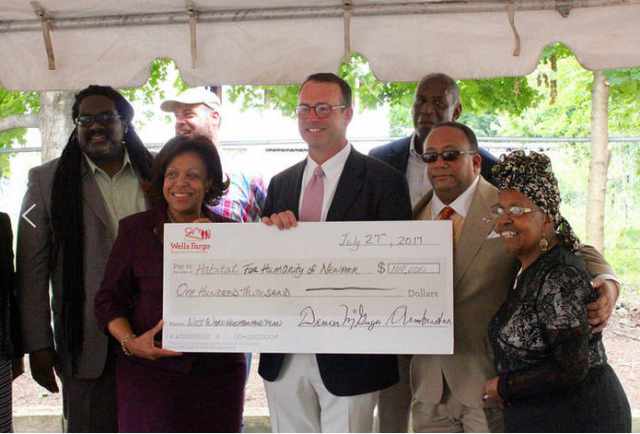NEWARK, NJ — Shovels dug into the earth, steadily burying the roots of five delicate saplings, as dark clouds loomed above this new Littleton Avenue park, near 14th Street. But the rain didn’t come.
In some ways, the scene on the morning of July 27 mimicked where Newark’s West Ward is right now: Crime and other social problems linger, but a group of community partners believe they’re planting the seeds of a better tomorrow.
The ceremonial tree planting was part of a celebration hosted by Habitat for Humanity of Greater Newark. Between speeches from local leaders, the nonprofit announced it had received $100,000 from the Wells Fargo Regional Foundation to undertake a yearlong planning initiative to revitalize the 2-square-mile West Ward.
But this project won’t be the kind in which a group of outsiders come in and dictate the fate of a neighborhood that’s not their own. Instead, the effort will rely on West Ward residents—at least 300 of them—and their thoughts on which aspects of the area must be improved, project leaders said.
“This is a resident-driven process,” Jeffrey J. Farrell, CEO of Habitat for Humanity of Greater Newark, told TAPinto Newark. “We’re going to see what the neighborhood and the residents want to see.”
So far, the group has surveyed some residents. Now that it has the money, it will continue that effort, he said, combing the neighborhood block by block and performing a “deep dive.”
The project is a new step for Habitat for Humanity. The organization typically focuses on affordable housing, building homes for families in need.
After the economic and social devastation wrought by the Great Recession, the Greater Newark chapter had what Board Chairman Carlton Daniels described as a “light-bulb” or “aha” moment.
“We can build homes,” Daniels told the dozens of people who attended the event, “but we need to start building communities.”
While Habitat’s planning effort may result in any number of directions, the group has already begun to work with local stakeholders to implement clearly-needed fixes.
Farrell said he’s working with PSE&G to add or fix streetlights, the police department to repair security cameras and the American Red Cross to install in-home smoke detectors. Other products of this experiment will include a college fair and a “critical repairs program,” which may help residents patch a roof or rid their basement of mold, he said.
But, far and away, the biggest issue is safety and security, Farrell said.
There was a time, in the early and mid-1900s, when much of Newark, including the West Ward, was not just safe. It was a place where people aspired to live.
Indeed, Irish, Ukrainian and other European immigrants settled in the ward’s various neighborhoods, from Vailsburg and Westside Ivy Hill to the Rosevilles and Fairmount. The area was prosperous and a launching pad to middle-class American life.
But predatory real estate practices slowly squeezed out those residents. Fearful of an influx of African-American residents, they headed to the suburbs and watched from afar as structural racism and institutional injustices waged war on the people who now occupied the old neighborhood.
Then came the 1967 Newark riots—a term many people from that time dislike, opting instead for “rebellion.” That bursting of tensions further damaged the West Ward. Over time, the decline of industry only worsened the situation.
While parts of the West Ward remain among the safer and more affluent portions of Newark, the neighborhood is home to much of the city’s violent crime. Flip through the headlines, and you’ll come across reports of murder—four over the course of one fall day, back in 2013—and drug-dealing.
Or just ask Donald Garland, a Newark resident of 75 years. He stood outside the ceremony today, curious about what was to come.
“Newark has nothing for the kids, and that’s what we need,” Garland told TAPinto Newark. “The good stuff going on close by isn’t happening here.”
Now, with the launch of Habitat for Humanity’s neighborhood revitalization project, Garland’s voice will be heard. And he might even inspire some real-world change.
This sort of boots-on-the-ground, communitywide effort is precisely what the Wells Fargo Regional Foundation looks for when opening its checkbook, said Denise McGregor Armbrister, the group’s executive director. Before presenting an oversize check to Farrell, she urged community members to own the project.
“It is critical—and let me say that again—it is critical that you seize the opportunity and get involved,” she said, calling on people to go the extra mile and become volunteers.
If the year goes as planned, Habitat for Humanity of Greater Newark stands to obtain more money, over the next five years, from the Wells Fargo foundation. That capital would help make these residents’ visions a reality, officials said.
“This is history in the making,” said Kevin Hill, a community leader who heads The Leaguers, which emphasizes early-childhood education.
And, with a few well-nourished seeds and a drive to keep digging, the West Ward as residents now know it could one day become history.

